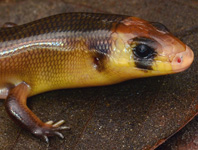Abstract
The spiders of the genus Loxosceles have been reported from caves in several regions of the world. Despite their commonness in subterranean habitats, the occurrence of troglomorphic species is quite rare. A new cave-dwelling species found in the Brazilian Caatinga can be included in the restricted list of troglomorphic Loxosceles by presenting the following troglomorphic traits: eyes with reduced diameter, absence of pigment around the eyes, appendage elongation and pale coloration. Thus, the aim of this study is to describe a new highly troglomorphic species of Loxosceles from Brazil, corresponding to the first troglomorphic species from South America. Loxosceles troglobia sp. nov. belongs to the gaucho group and can be distinguished from the other species of this group mainly by the presence of the troglomorphic characteristics mentioned above and by the shape of the female spermathecae and the male palp. The morphological traits, together with the fact that the new species was found only in inner and very humid portions of two nearby caves, indicate that it is troglobitic.
References
Bertani, R., Fukushima, C.S. & Nagahama, R.H. (2010) Loxosceles chapadensis (Araneae: Sicariidae): a new recluse spider species of the gaucho group from Brazil. Journal of Arachnology, 38 (2), 364–367.
https://doi.org/10.1636/A09-92.1Brignoli, P.M. (1972) Sur quelques araignées cavernicoles d'Argentine, Uruguay, Brésil et Venezuela récoltées par le Dr. P. Strinati (Arachnida, Araneae). Revue Suisse de Zoologie, 79, 361–385.
https://doi.org/10.5962/bhl.part.97130Cala-Riquelme, F., Gutiérrez-Estrada, M.A. & Flórez-Daza, E. (2015) The genus Loxosceles Heineken & Lowe 1832 (Araneae: Sicariidae) in Colombia, with description of new cave-dwelling species. Zootaxa, 4012 (2), 396–400.
https://doi.org/10.11646/zootaxa.4012.2.12Chomphuphuang, N., Deowanish, S., Songsangchote, C., Sivayyapram, V., Thongprem, P. & Warrit, N. (2016) The Mediterranean recluse spider Loxosceles rufescens (Dufour, 1820) (Araneae: Sicariidae) established in a natural cave in Thailand. Journal of Arachnology, 44 (2), 142–147.
https://doi.org/10.1636/R15-61Christiansen, K.A. (1962) Proposition pour la classification des animaux cavernicoles. Spelunca, 2, 75–78.
Fukushima, C.S., Andrade, R.M.G. de & Bertani, R. (2017) Two new Brazilian species of Loxosceles Heinecken & Lowe, 1832 with remarks on amazonica and rufescens groups (Araneae, Sicariidae). ZooKeys, 667, 67–94.
https://doi.org/10.3897/zookeys.667.11369Gertsch, W.J. (1967) The spider genus Loxosceles in South America (Araneae, Scytodidae). Bul-letin of the American Museum of Natural History, 136, 117–174.
Gertsch, W.J. & Ennik, F. (1983) The spider genus Loxosceles in North America, Central America, and the West Indies (Araneae, Loxoscelidae). Bulletin of the American Museum of Natural History, 175, 264–360.
Gonçalves-de-Andrade, R.M., Galati, E.A.B. & Tambourgi, D.V. (2001) Presença de Loxosceles similis Moenkhaus, 1898 (Araneae, Sicariidae) na Serra da Bodoquena, Estado de Mato Grosso do Sul, Brasil. Revista da Sociedade Brasileira de Medicina Tropical, 34 (3), 275–277.
https://doi.org/10.1590/S0037-86822001000300008Gonçalves-de-Andrade, R.M., Bertani, R., Nagahama, R.H. & Barbosa, M.F.R. (2012) Loxosceles niedeguidonae (Araneae, Sicariidae) a new species of brown spider from Brazilian semi-arid region. ZooKeys, 175, 27–36.
https://doi.org/10.3897/zookeys.175.2259Holsinger, J.R. & Culver, D.C. (1988) The invertebrate cave fauna of Virginia and a part of Eastern Tennessee: Zoogeography and ecology. Brimleyana, 14, 1–162.
Irish, J., Marais, E., Juberthie, C. & Decu, V. (2001) Namibia. In: Juberthie, C. & Decu, V. (Eds.), Encyclopedia Biospeologica. Vol. 3. Société de Biospéologie, Moulis, pp. 1639–1650.
Lotz, L.N. (2012) Present status of Sicariidae (Arachnida: Araneae) in the Afrotropical region. Zootaxa, 3522, 1–41.
Lotz, L.N. (2017) An update on the spider genus Loxosceles (Araneae: Sicariidae) in the Afrotropical region, with description of seven new species. Zootaxa, 4341 (4), 475–494.
https://doi.org/10.11646/Zootaxa.4341.4.2Mammola, S. & Isaia, M. (2017) Spiders in caves. Proceedings of the Royal Society B: Biological Sciences, 284 (1853), 1–10.
https://doi.org/10.1098/rspb.2017.0193Mammola, S., Cardoso, P., Ribera, C., Pavlek, M. & Isaia, M. (2017) A synthesis on cave-dwelling spiders in Europe. Journal of Zoological Systematics and Evolutionary Research, 1–16.
https://doi.org/10.1111/jzs.12201Moenkhaus, W.J. (1898) Contribuição para o conhecimento das aranhas de S. Paulo. Revista do Museu Paulista, 3, 77–112.
https://doi.org/10.5962/bhl.part.12292Mundie, D.A. (1995) The NBS/ISCC Color System. Pittsburgh, Pennsylvania. Available from: http://people.csail.mit.edu/jaffer/Color/Dictionaries#nbs-iscc (accessed 16 October 2017).
Newlands, G. (1980) A new spelaean species of Loxosceles (Araneae: Sicariidae). Journal of the Entomological Society of South Africa, 43 (2), 367–369.
Niemiller, M.L., Graening, G.O., Fenolio, D.B., Godwin, J.C., Cooley, J.R., Pearson, W.D., Fitzpatrick, B.M. & Near, T.J. (2013) Doomed before they are described? The need for conservation assessments of cryptic species complexes using an amblyopsid cavefish (Amblyopsidae: Typhlichthys) as a case study. Biodiversity and Conservation, 22 (8), 1799–1820.
https://doi.org/10.1007/s10531-013-0514-4Planas, E. & Ribera, C. (2015) Description of six new species of Loxosceles (Araneae: Sicariidae) endemic to the Canary Islands and the utility of DNA barcoding for their fast and ac-curate identification. Zoological Journal of the Linnean Society, 174 (1), 47–73.
https://doi.org/10.1111/zoj.12226Ribera, C. (2004) Arachnida: Araneae (Spiders). In: Gun, J. (Ed.), Encyclopaedia of caves and karst sciences. Fitzroy Dearborn, New York, pp. 71–73.
Ribera, C. & Juberthie, C. (1994) Araneae. In: Juberthie, C. & Decu, V. (Eds.), Encyclopedia Biospeologica. Vol. I. Société de Biospéologie, Moulis, pp. 197–214.
Růžička, V., Šmilauer, P. & Mlejnek, R. (2013) Colonization of subterranean habitats by spiders in Central Europe. International Journal of Speleology, 42 (2), 133–140.
https://doi.org/10.5038/1827-806X.42.2.5Sadeghi, S., Dashan, M. & Malek-Hosseini, M.J. (2017) Mediterranean Recluse Spider, Loxosceles rufescens (Araneae: Sicariidae) from Charkhab Cave, southern Iran. Journal of Arthropod-Borne Diseases, 11 (1), 156–160.
Sánchez-Ruiz, A. & Brescovit, A.D. (2013) The genus Loxosceles Heineken & Lowe (Araneae: Sicariidae) in Cuba and Hispaniola, West Indies. Zootaxa, 3731 (2), 212–222.
https://doi.org/10.11646/zootaxa.3731.2.2Simon, E. (1893) Histoire naturelle des araignées. Librairie Encyclopédique de Roret, Paris, 1084 pp.
Simon, E. (1894) Note sur les arthropodes cavernicoles du Transvaal. Annales de la Société Entomologique de France, 63, 63–67.
Souza-Silva, M. & Ferreira, R.L. (2014) Loxosceles spiders (Araneae: Sicariidae) preying on invertebrates in Brazilian caves. Speleobiology Notes, 6, 27–32
Tahami, M.S., Zamani, A., Sadeghi, S. & Ribera, C. (2017) A new species of Loxosceles Heineken & Lowe, 1832 (Araneae: Sicariidae) from Iranian caves. Zootaxa, 4318 (2), 377–387.
https://doi.org/10.11646/zootaxa.4318.2.10Watling, R. & Pernetta, J.C. (1977) Limestone caves in the Sigatoka Valley, Viti Levu, Fiji. Studies in Speleology, 3, 78–86.

